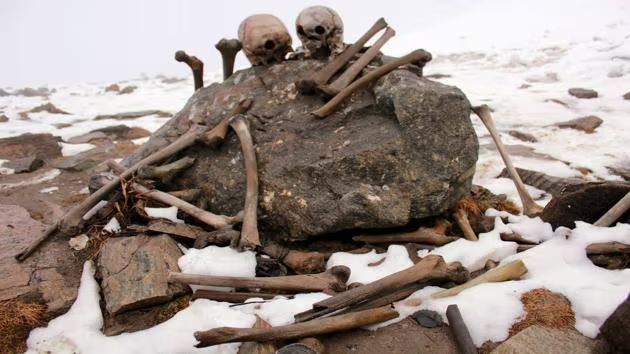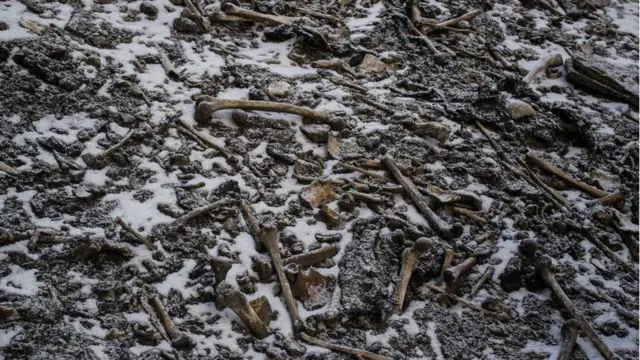The Wailing Woman of Roopkund Lake: Uttarakhand’s Haunting Mystery
High in the Garhwal Himalayas of Uttarakhand, at an altitude of 5,029 meters, lies Roopkund Lake, famously known as the “Skeleton Lake” for the hundreds of human remains scattered in its icy waters. But beyond the scientific intrigue of these ancient skeletons, a chilling local legend whispers through the alpine meadows and snow-clad peaks—the tale of The Wailing Woman of Roopkund Lake. This ghostly figure, said to haunt the lake’s desolate shores, has captivated trekkers, locals, and paranormal enthusiasts alike. In this blog, we dive into the eerie story of the Wailing Woman, explore its roots in Uttarakhand’s folklore, and uncover why Roopkund remains one of India’s most mysterious destinations.
Roopkund Lake: The Enigmatic Skeleton Lake
Nestled in the Chamoli district of Uttarakhand, Roopkund Lake is a glacial tarn surrounded by the majestic Trishul massif and Nanda Ghunti peaks. At 16,499 feet, it’s a grueling trek from the nearest village, accessible only during a brief window in late summer and autumn when the ice melts. The lake, just 40 meters in diameter, gained global attention in 1942 when a British forest ranger, Hari Kishan Madhwal, stumbled upon hundreds of human skeletons—some with flesh still attached—visible in the clear waters.
Scientific studies, including a 2019 genetic analysis, revealed that the remains, dating from 800 CE to 1800 CE, belong to diverse groups, including South Asians and even Mediterranean individuals, deepening the lake’s mystery. But for the local Garhwali people, the lake is more than a scientific puzzle—it’s a sacred site steeped in myth, where the divine and the supernatural converge. Among these tales, the legend of the Wailing Woman stands out as the most haunting.

The Legend of the Wailing Woman
According to local folklore, the Wailing Woman is the restless spirit of a queen, often identified as Rani Balampa, the pregnant wife of Raja Jasdhaval, a medieval king of Kanauj. The story, passed down through generations in the villages of Wan and Bedni Bugyal, tells of a fateful pilgrimage to honor the goddess Nanda Devi, whose shrine lies near Roopkund.
A Doomed Pilgrimage
In the 9th century, Raja Jasdhaval, overjoyed by the impending birth of his heir, embarked on a grand pilgrimage to the Nanda Devi shrine, accompanied by his pregnant queen, Rani Balampa, a lavish entourage of dancers, musicians, and servants. Ignoring the warnings of priests who deemed the journey inauspicious during the queen’s pregnancy, the king’s procession was marked by revelry—singing, dancing, and feasting—that violated the sanctity of the sacred mountains.
As the group neared Roopkund Lake, Rani Balampa went into labor, further angering Nanda Devi, who considered the birth on her holy ground an act of impurity. Enraged, the goddess unleashed a catastrophic hailstorm, with hailstones “as hard as iron” the size of cricket balls. The entire party—king, queen, unborn child, and hundreds of followers—was pelted to death, their bodies hurled into the lake’s icy depths.
The Wailing Woman’s Curse
While the skeletons of the pilgrims remain as silent witnesses, locals believe Rani Balampa’s spirit never found peace. Her grief over her unborn child and the destruction of her entourage transformed her into the Wailing Woman, a spectral figure doomed to wander Roopkund’s shores. Trekkers and shepherds report hearing her mournful cries echoing through the fog, a piercing wail that chills the soul. Some claim to see a woman in tattered royal garments, her face obscured, standing motionless by the lake before vanishing into the mist.
The legend holds that the Wailing Woman seeks her lost child, her cries growing louder during the Nanda Devi Raj Jat, a festival held every 12 years when pilgrims honor the goddess. Villagers warn that disrespecting the lake—such as removing bones as souvenirs—invokes her wrath, bringing misfortune or deadly storms.

Paranormal Encounters at Roopkund Lake
Roopkund’s remote location and eerie history make it a hotspot for paranormal tales. Trekkers and locals have shared spine-chilling experiences that fuel the legend of the Wailing Woman:
- Mournful Cries: Many report hearing a woman’s sobs or wails at dawn or dusk, especially near the lake or the nearby Junargali ridge, even when no one is around.
- Ghostly Apparitions: Some trekkers claim to have seen a shadowy female figure near the lake, often described as wearing flowing robes, only to disappear when approached.
- Sudden Storms: Locals attribute unexpected hailstorms or blizzards to the Wailing Woman’s anger, echoing the fatal storm that killed her entourage.
- Uneasy Feelings: Campers at Bhagwabasa, the base camp for Roopkund, describe an oppressive sense of being watched or unexplained cold spots, even in summer.
These accounts, combined with the lake’s macabre skeletal remains, have made Roopkund a must-visit for adventure seekers and paranormal enthusiasts. The 53-km trek, starting from Lohajang Pass, is as much a journey into Uttarakhand’s natural beauty as it is a descent into its supernatural lore.
The Cultural and Scientific Context
The legend of the Wailing Woman is deeply tied to the Garhwali reverence for Nanda Devi, a manifestation of the goddess Parvati. The lake itself is linked to Hindu mythology, with some stories claiming Lord Shiva created Roopkund (“Roop” meaning form, “Kund” meaning lake) for Parvati to admire her reflection. The Nanda Devi Raj Jat pilgrimage, which passes near Roopkund, reinforces the area’s spiritual significance.
Scientifically, the hailstorm theory aligns with the legend. Forensic studies in 2004 confirmed that many skeletons bear skull fractures from blunt, round objects, consistent with large hailstones. However, the 2019 genetic study revealed that not all remains are from the same event, with some dating to 1800 CE and others showing Mediterranean ancestry, suggesting multiple tragedies over centuries. These findings add layers to the Wailing Woman’s tale—could she represent multiple lost souls, or is her story a cultural explanation for the lake’s grim history?
Why Visit Roopkund Lake?
Roopkund Lake is a bucket-list destination for trekkers and mystery lovers. The 8-day trek, rated moderate to difficult, offers stunning views of Himalayan peaks, vibrant meadows like Bedni Bugyal, and rare flora like the Brahma Kamal, Uttarakhand’s state flower. The lake’s eerie ambiance, coupled with the Wailing Woman’s legend, creates a unique blend of adventure and intrigue.
Trekking Tips
- Best Time: Mid-September to October or May to June, when the lake is accessible and meadows are in bloom. Avoid winter due to heavy snow.
- Preparation: Prior trekking experience is recommended due to steep climbs and high altitude. Pack sturdy trekking shoes, warm clothing, and a rain cover.
- Respect the Site: Avoid disturbing the skeletons or artifacts, as it’s disrespectful to local beliefs and harms the site’s preservation.
- Travel Logistics: Start from Lohajang Pass, reachable by cab from Haridwar or Rishikesh. Book through trusted operators for guided treks.
Conclusion: Dare to Face the Wailing Woman?
The Wailing Woman of Roopkund Lake is more than a ghost story—it’s a haunting blend of history, mythology, and the raw power of the Himalayas. Whether you’re drawn by the thrill of trekking, the enigma of the skeletons, or the chilling legend of Rani Balampa’s spirit, Roopkund offers an adventure like no other. As you stand by the lake, listening to the wind howl through the peaks, you might just hear her wail—a reminder of the mountains’ untamed mysteries.
Have you trekked to Roopkund or heard tales of the Wailing Woman? Share your experiences in the comments, and subscribe for more spooky stories from India’s haunted landscapes!
Disclaimer: The legend of the Wailing Woman is based on local folklore and may vary across sources. Approach paranormal claims with curiosity and respect for cultural beliefs.If you trek to Roopkund, pause by the lake as clouds gather. Feel the weight of the silence, the chill that defies the sun, and listen for the wind’s song. You might hear nothing—or you might catch a faint wail, a queen’s sorrow calling across centuries, forever bound to the Skeleton Lake.
